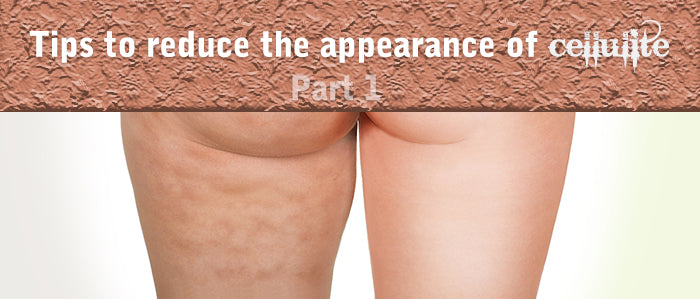Tips to reduce the appearance of cellulite, part 1 Cellulite is an extremely common, completely benign skin condition. While for many people, it’s just a fact of life – and why not? – for others it can be a source of embarrassment: many would like nothing better to get rid of it. It’s estimated that 90% of the women will have some degree of cellulite at different ages, regardless of their weight. There’s nothing wrong with having cellulite Why do people get cellulite, and what are some methods to reduce its appearance? We’ve made a guide to understand it better, and laid out some techniques to lessen its appearance for those who’d rather try to lessen its appearance.
(Rossi, Pinna) Cellulite, then, is a type of fat formation that’s visible on the skin – and since everyone has fat in their bodies, regardless of their weight, it can then affect people of all sizes. It looks very similar to an orange peel in texture, and it typically appears on thighs, hips and backsides. Cellulite can further be categorized into three different degrees. No cellulite: No dimpling visible on skin, even pinched. Level 1: No cellulite is visible on skin when at rest. If you pinched your thighs or other areas with fat, you will observe the cellulite. Level 2: Cellulite is visible without pressure when standing,but will disappear when lying down or sitting. Level 3: Cellulite is visible without pressure all the time at any posture.
Why do people develop cellulite?
Cellulite is so common that it’s medically considered a secondary sex characteristic, though it can of course affect people of all gender identities. It is therefore not perhaps so interesting to ask why people get it, but what can make it more or less pronounced. Cellulite is tied to genetic factors, hormonal factors, specifically estrogen and progesterone production, and lifestyle.
Can I get rid of cellulite permanently?
Though many products and approaches claim that it is possible, there have been no proven treatments that can completely rid someone of cellulite. Some treatments, however, do provide a temporary reduction in cellulite’s appearance, even in some cases making it temporarily invisible. Some lifestyles, moreover, can curb cellulite in the sense that they make it less likely to become more pronounced.
Then, what can I do about my cellulite?
Though it may seem disheartening for some that it’s impossible to completely get rid of cellulite, the good news is that reducing its appearance temporarily (though sometimes long term!) is absolutely achievable. What we mean by temporary, yet long term? It isn’t possible to completely restructure the layer of fat under your skin, but it is possible to make your skin look smoother, and to prevent cellulite from becoming more pronounced. For example, developing a higher muscle to fat ratio can make the body look firmer; keeping hydrated will make dimples on the skin look smoother; and finally, tans will mask cellulite’s appearance, making it less noticeable. Another common treatment for cellulite is massage, especially when it is accompanied by targeted balms and lotions. Vitamin C and Vitamin E have both been linked to collagen synthesis, a protein that structures connective tissue in the body: the very same connective tissues that, when too small, create the orange peel texture of cellulite. These vitamins can both be absorbed through the skin. Essential oils rich in Vitamin C and massage oils rich in Vitamin E can therefore be beneficial during treatment: citrus and rosemary are particularly popular for this use. Of course, essential oils such as these should not be applied on the skin directly, and therefore they are commonly mixed with carrier oils. Massage treatments, in turn, can help rid the skin of excess fluid that can contribute to creating a bumpy appearance on the skin. While largely considered to have a short term effect, massaging cellulite-prone areas regularly is a surprisingly pleasant, effective way of ensuring that your skin looks firm and smooth. Of course, not everyone can afford to get massage appointments regularly – but never fear, there are some easier alternatives to integrate into your routine! Cupping massage is a wonderful way of getting most of the beneficial effects of an anti-cellulite massage without breaking the bank, and it can be done at home quite easily, and with minimal training.
What is a cupping massage?
Cupping massage has a few names, ranging from “moving cupping,” “sliding cupping,” “gliding cupping” and, of course, “cupping massage.”We prefer the last term because it provides a more familiar image. In any case, cupping massage refers to smooth motions of therapeutic cups across the skin, which is usually lubricated with massage oils, gels, lotions, creams or balms. This motion can be surprisingly relaxing, and commonly makes the patient feel as though the tension has quite literally been sucked out of their bodies.
How can cupping massage help reduce the appearance of cellulite?
The mechanism which makes massage reduce fluid deposits across the skin also operates in cupping massages. The addition of suction cups allows people to achieve this effect relatively effortlessly, since an in-depth, vigorous daily massage can be quite taxing and time-consuming. In fact, the suction itself is more pronounced using cups, and therefore it is particularly appropriate for this purpose. If you are looking for acupuncturists who could treat reducing the appearance of cellulite, we recommend Clinic d’Acupuncture Laval. About the acupuncturist: Xiao Lei Wang is a professional TCM therapist with Quebec registered acupuncturist licence. He focuses on helping patients with Traditional Chinese medicine including acupuncture, moxibustion and cupping therapies. You can find more about him on his own acupuncture clinic website. You could also book an appointment on the website. All right reserved for Lierre Blog


